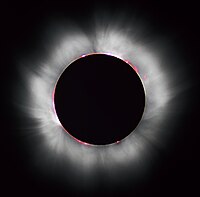
Photo from wikipedia
Abstract Ionospheric response during the annular solar eclipse of June 21, 2020, has been examined in terms of the Total Electron Content (TEC) obtained from six Global Positioning System (GPS)… Click to show full abstract
Abstract Ionospheric response during the annular solar eclipse of June 21, 2020, has been examined in terms of the Total Electron Content (TEC) obtained from six Global Positioning System (GPS) receivers positioned in the Chinese-Taiwanese region. We have shown TEC variation from satellites designated by PRNs (Pseudo-Random Noise code) 2, 6, and 19. PRN wise TEC trend was observed to depend upon satellite-pass trajectory to the receiver's location during the eclipse period. A time lag of ∼ 15-30 minutes is also observed in maximum TEC decrement after the phase of maximum eclipse. Instead of the percentage of eclipse magnitude, a reduction in TEC is seen more for the station for which the orbital track of respective satellites was in closer view relative to receivers for more hours of eclipse window. Additionally, the eclipse day diurnal variations are compared with the pre-eclipse day TEC trend, and observed results show a clear decrease in TEC values at all chosen stations after the eclipse onset then reached the lowest value a few minutes afterward the maximum eclipse phase.
Journal Title: Advances in Space Research
Year Published: 2021
Link to full text (if available)
Share on Social Media: Sign Up to like & get
recommendations!